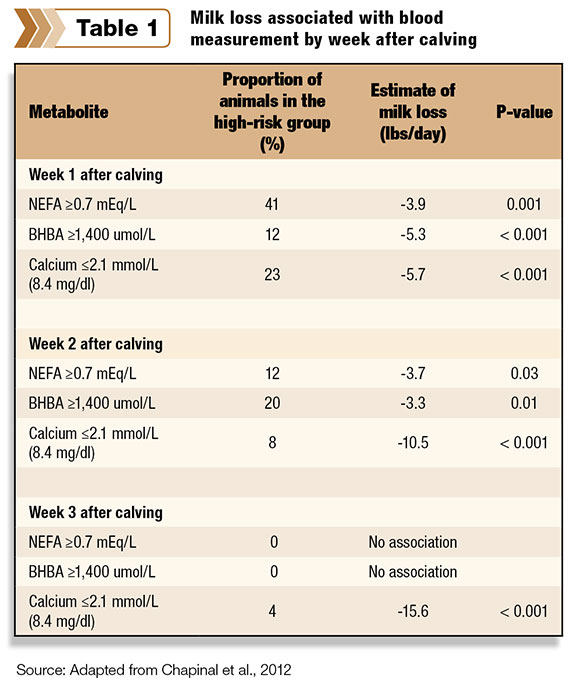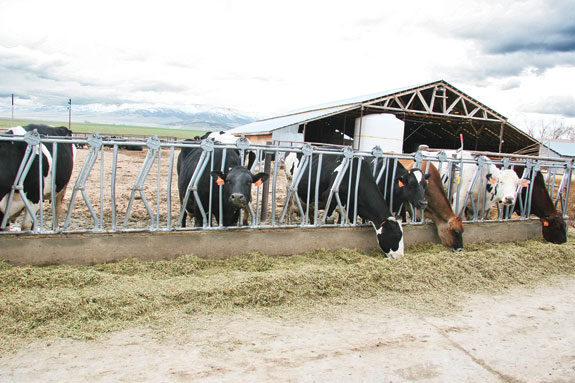The transition from late pregnancy to lactation requires enormous physiological adaptations from the dairy cow. One of the most important changes that occurs involves the balance of calcium. Cows unable to maintain adequate blood-calcium concentrations are susceptible to higher rates of early postpartum metabolic disorders and produce less milk.
These cows are classified as either subclinical hypocalcemic (just below normal), and have blood calcium concentrations between 5.5 and 8.0 mg per dl, or clinical hypocalcemic, more commonly referred to as milk fever, with blood calcium concentrations below 5.5 mg per dl (significantly below normal).
A forgotten problem

The importance of maintaining adequate blood calcium concentrations in the transition dairy cow has been forgotten and overlooked.
Research published in 2012 illustrates calcium’s importance in early lactation milk yield compared to two important energy metabolites more commonly monitored in fresh cows (see Table 1 ).
This research shows that low blood calcium concentrations have a greater negative influence on milk yield than non-esterified fatty acids (NEFA) or beta-hydroxybutyric acid (BHBA) and this condition may persist through the first three weeks following calving.
The cost of a hidden disease
While our understanding of calcium metabolism in transition dairy cows is good, it is not complete.
This has led to considerable differences in recommendations for feeding prepartum dairy cows for the purpose of maintaining adequate blood calcium concentrations and reducing incidence rates of both clinical and subclinical hypocalcemia.
Contributing to these differences in recommendations is the disagreement within the dairy industry as to the proper threshold level for subclinical hypocalcemia.
The traditional blood calcium concentration used to determine subclinical hypocalcemia is 8.0 mg per dl. Recent research, however, challenges this traditional threshold and suggests a more appropriate concentration for peri-parturient dairy cows to be at or above 8.5 mg per dl.
By raising the threshold level for subclinical hypocalcemia to 8.5 mg per dl, and using 2011 data from the National Animal Disease Center in Ames, Iowa, the incidence levels of subclinical hypocalcemia increases from 25 to 51 percent, 41 to 61 percent and 49 to 67 percent for first-parity, second-parity and third-parity cows, respectively.
While each case of clinical hypocalcemia (milk fever) carries with it a more significant cost than subclinical hypocalcemia ($300 compared to $125), the lost revenue associated with subclinical hypocalcemia far exceeds that of clinical hypocalcemia because rates of subclinical hypocalcemia on typical dairy farms exceed those of clinical cases by 15 times.
Recent studies
Recent work published in the Journal of Dairy Science supports two important concepts:
1. Subclinical hypocalcemia before and after calving has significant negative effects on milk yield and reproduction.
2. The concept of raising the threshold level for subclinical hypocalcemia from 8.0 to 8.5 mg per dl more adequately describes the point where negative effects on animal health and performance begin.
In a study of 55 herds and more than 1,900 cows, researchers demonstrated two key points:
1. Within the week prior to calving, high-risk cows (cows with blood calcium concentrations equal to or less than 8.4 mg per dl) produced 7 pounds less milk across the first four Dairy Herd Improvement Association (DHIA) tests than low-risk cows (cows above 8.4 mg per dl).
2. Cows falling within the high-risk group within one, two and three weeks post-calving produced significantly less milk at first DHIA test than low-risk cows (see Table 1), demonstrating that low blood calcium concentrations both before and after calving have significant negative effects on early lactation milk yield.
This is an important point to remember when considering a strategy to reduce subclinical hypocalcemia. Treatment with oral products (although warranted for clinically hypocalcemic and postpartum cows) does not address the negative impact prepartum subclinical hypocalcemia has on milk yield.
Calcium status around the time of calving also has been shown to influence reproduction. Research reported that cows with blood calcium concentrations of more than 9.2 mg per dl pre-calving were 1.5 times more likely to conceive at first A.I.
Cows with post-calving blood calcium concentrations during the first three weeks of lactation were 1.3 times more likely to conceive at first A.I. if blood calcium concentrations were:
• Week one after calving: More than 8.8 mg per dl
• Week two after calving: More than 9.2 mg per dl
• Week three after calving: More than 9.6 mg per dl
University of Florida research in 2012 suggests a more appropriate threshold for blood calcium concentrations may be 8.59 mg per dl when they are monitored within the first three days of lactation.
Researchers observed that cows classified with subclinical hypocalcemia were at greater risk of developing fever and metritis, and had reduced pregnancy rates and longer intervals to pregnancy than cows that had adequate blood calcium concentrations.
Practical guidelines for success
The benefits of maintaining adequate blood calcium concentrations in transition cows is well documented, including reduced incidence of metabolic diseases, fewer infectious diseases, higher milk production and better reproduction.
The most practical and effective way to reduce clinical and subclinical hypocalcemia is to feed a negative dietary cation-anion difference (DCAD) diet prepartum. Consider these guidelines for managing a successful negative prepartum DCAD diet:
• Fully acidify the diet between a DCAD of -10 to -15 mEq per 100g. Selection of an anionic mineral product that is palatable can help attain a low DCAD while maintaining high dry matter intakes.
• Monitor urine pH values routinely, especially after significant dietary ingredient changes, to ensure cows are fully acidified. Target urine pH for Holsteins between 6.0 and 6.3 and Jerseys between 5.8 and 6.2. Check water quality, since hardness, pH, alkalinity and mineral content may affect acidification of the animal.
• Feed for a minimum of 21 days prepartum. Remember that some cows calve early, and it is better to be longer than shorter on days spent in the close-up pen. Properly balanced negative DCAD diets can be fed safely for long periods of time.
• Feed proper levels of calcium (165 to 190 g per day), phosphorus (43 to 50 g per day), magnesium (53 to 59 g per day), chloride (94 to 118 g per day) and sulfur (51 to 55 g per day).
• Periodically sample a subpopulation of fresh cows to determine total blood calcium concentrations on the day of calving and potentially through the first week of lactation.
Recent research has refocused our attention on the importance of calcium in the transition dairy cow. Properly feeding an anionic diet along with periodic monitoring of urine pH, day-of-calving blood calcium levels and fresh-cow health events and start-up milk can pay big dividends to herd profitability. PD
Zanzalari has a Ph.D. in animal science from the University of Tennessee and is an ARPAS board-certified nutritionist with Prince Agri Products, Inc. specializing in transition cow management and nutrition.
References omitted due to space but are available upon request. Click here to email an editor.
PHOTO
While our understanding of calcium metabolism in transition dairy cows is good, it is not complete. This has led to considerable differences in recommendations for feeding prepartum dairy cows... Photo by PD staff.

Ken Zanzalari
Dairy Technology Manager
Prince Agri Products









